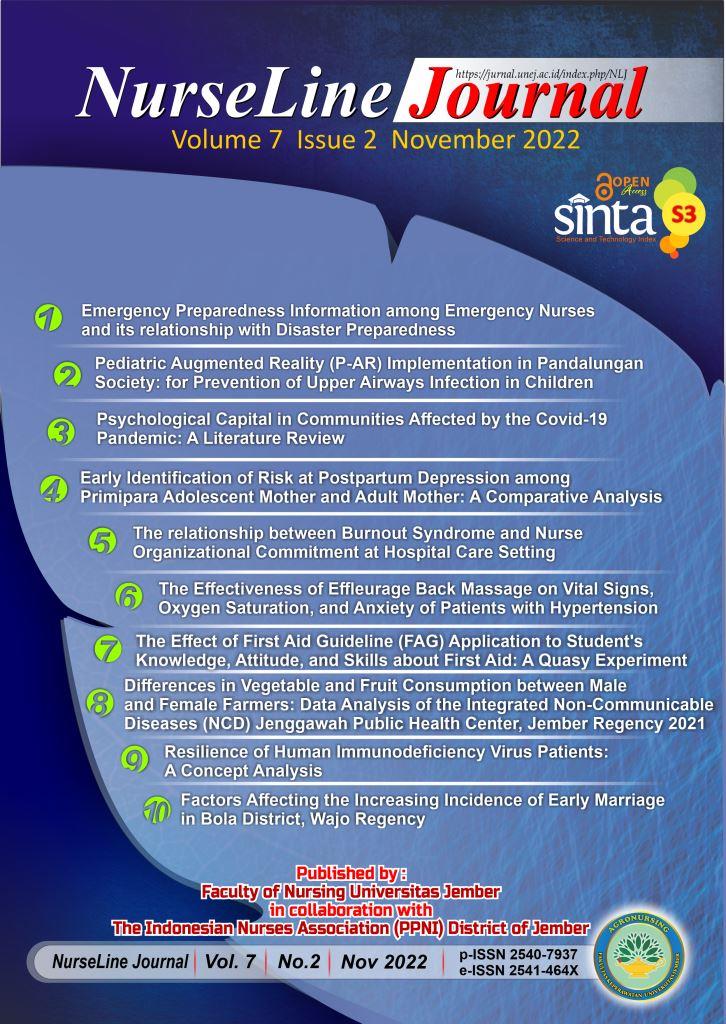Emergency Preparedness Information among Emergency Nurses and Its Relationship with Disaster Preparedness
DOI:
https://doi.org/10.19184/nlj.v7i2.28010Keywords:
Emergency Preparedness Information, Nurses, Disaster PreparednessAbstract
Nurses are health workers who play an essential role in disaster management, so the right strategy is needed in disaster preparedness. Management of disaster is an intervention in the Emergency Department (ED) that has an essential role in preparedness, emergency responses, and recovery to reduce the effects during and after the disaster. Emergency preparedness information in the ED has a scope like triage and first aid, biological agent detection, accessing critical resources and reporting, the incident command system (ICS), isolation, quarantine and decontamination, psychological issues, epidemiology and clinical decision making, communication and connectivity. This study aims to determine the emergency preparedness information and disaster preparedness. This study used a cross-sectional study design, conducted in three emergency department of a disaster referral hospital in Padang City. Respondents participated in this study were selected using a purposive sampling technique with inclusion criteria, as many as 61 respondents were selected. A few instruments were used in this study. Emergency Preparedness Information Questionnaire (EPIQ), which aims to measure the preparedness of emergency nurses in dealing with disasters, and the Disaster Preparedness Evaluation Tools (DPET) ® determine the preparedness of nurses in dealing with disasters. The variables in this study were tested using the Pearson statistical test, which tested the relationship between emergency room nurses' preparedness to deal with disasters and disaster preparedness. The results shows the relationship between the emergency preparedness information and the disaster preparedness among nurses with a p-value of 0.003, with low correlation r-value of 0.373. The emergency department is a health service that provides emergency response when disaster occurs. So that the emergency preparedness information must be improved in dealing with disaster situations becomes optimal.
Downloads
References
Ali, M., Sultan, S., Mary, P. E., Salem, H., & Grad, A. (2017). Emergency Nurses Readiness for Disaster Response-An Explorative Study. American Research Journal of Nursing, 4(1), 1–10.
Alzahrani, F., & Kyratsis, Y. (2017). Emergency nurse disaster preparedness during mass gatherings : a cross-sectional survey of emergency nurses' perceptions in hospitals in Mecca , Saudi Arabia Study design. 1–10. https://doi.org/10.1136/bmjopen-2016-013563
Amberson, A. T., Wells, C., Gossman, S., & Jolla, L. (2020). Increasing Disaster Preparedness In Emergency Nurses : A Quality Improvement Initiative Staff Emails. Journal of Emergency Nursing, 46(5), 654-665.e21. https://doi.org/10.1016/j.jen.2020.05.001
BNPB, B. N. P. B. (2018). Buku Saku; Tanggap Tangkas Tanggug Menghadapi Bencana (2018th ed.).
BPBD. https://www.beritasatu.com/nasional/760305/bnpb-bencana-di-indonesia-95-adalah-bencana-hidrometeorologi accessed date 21st May 2021
BNPB. 2021. https://bnpb.go.id/berita/bencana-hidrometeorologi-dominan-sepanjang-awal-januari-hingga-akhir-april-2021- accessed date 21st May 2021
BPBD. 2021. https://gis.bnpb.go.id/arcgis/apps/Cascade/index.html?appid=adb735cf30134c5cb503c8887a60d424 accessed date 26th May 2021
BNPB.2021. https://gis.bnpb.go.id/arcgis/apps/Cascade/index.html?appid=4faab6b84b1c4d1e8e292d0b60f8be76. accessed date 26th May 2021
BPS. 2021. https://www.bps.go.id/indicator/168/954/1/banyaknya-desa-kelurahan-menurut-jenis-bencana-alam-dalam-tiga-tahun-terakhir.html accessed date 21st May 2021
Georgino, M. M., Kress, C. T., Alexander, S., & Beach, R. N. M. (2015). Emergency Preparedness Education for Nurses. 22(5). https://doi.org/10.1097/JTN.0000000000000148
Li, H., Bi, R., & Zhong, Q. (2017). Nurse Education Today The development and psychometric testing of a Disaster Response Self- E ffi cacy Scale among undergraduate nursing students. Nurse Education Today, 59(July), 16–20. https://doi.org/10.1016/j.nedt.2017.07.009
Martono, M., Satino, S., Nursalam, N., Efendi, F., & Bushy, A. (2019). Indonesian nurses' perception of disaster management preparedness. Chinese Journal of Traumatology, 22(1), 41–46. https://doi.org/10.1016/j.cjtee.2018.09.002
Nursing, I. C. of. (2009). ICN Framework of Disaster Nursing Competencies.
Rizqillah, A. F. (2018). Disaster Preparedness : Survey Study pada Mahasiswa Keperawatan Universitas Harapan Bangsa Purwokerto. Medisains: Jurnal Ilmiah Ilmu-Ilmu Kesehatan, 16(3), 114–119.
Seyedin, H., Dolatabadi, Z. A., & Rajabifard, F. (2015). Emergency Nurses' Requirements for Disaster Preparedness. 20(4). https://doi.org/10.5812/traumamon.29033
Shoji, M., Takafuji, Y., & Harada, T. (2020). International Journal of Disaster Risk Reduction Behavioral impact of disaster education : Evidence from a dance-based program in Indonesia. International Journal of Disaster Risk Reduction, 45(August 2019), 101489. https://doi.org/10.1016/j.ijdrr.2020.101489
Zhong, S., Clark, M., Hou, X., Zang, Y., & Fitzgerald, G. (2014). Validation of a Framework for Measuring Hospital Disaster Resilience Using Factor Analysis. 6335–6353. https://doi.org/10.3390/ijerph110606335








